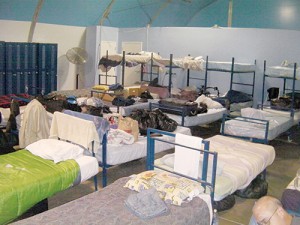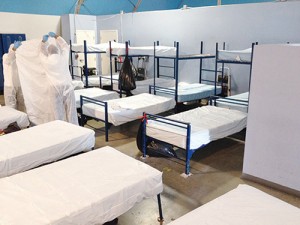
The Samoshel shelter as Bird Pest Barrier found it.
One hundred beds, three rooms and countless bed bugs. That’s the challenging circumstances Donna Miller, the director of operations for the Samoshel homeless shelter in Santa Monica, Calif. was up against last October. It was a bad situation made worse by the nature of the infested structure — a place where people from all walks of life come when they have nowhere else to go.
According to Miller it was one of the worst bed bug problems she could imagine. The situation was bad, impacted by a very limited budget and a perpetually changing occupancy.
All of the residents had complained of being bitten and bed bugs were easily visible on their blankets during daylight hours. Samoshel’s staff and residents did what they could without the professional help the job required, whether it meant keeping their possessions in plastic trash bags or putting the legs of their beds in buckets of water.
According to Cameron Riddell, president of Bird Barrier/Pest Barrier, 100 beds were placed in three different rooms of a temporary structure. Low walls separated the rooms and considering the countless infested possessions and bedding, and infrequent laundering, Riddell considered the shelter a “zero control site.”
When Pest Barrier heard about the situation they offered a free treatment with Cimi-Shield, the company’s green bed bug treatment.
“But we were nervous,” Riddell said. “The problem was so vast with so much food and easy passageways, we didn’t think anything could possibly solve the problem, but we decided to give it a try anyway.”

The Samoshel shelter duing treatment.
On paper, Pest Barrier’s offer looked good to Miller, so once she received the ok from her executive director, the wheels of treatment were set in motion.
Three weeks before treatment began, a dozen insect interceptors were positioned randomly under bunk-bed legs around the shelter. Nearly 200 bed bugs were caught by outer rings and 46 by inner rings before treatment even began.
On October 29, after residents’ beds were stripped and their bedding laundered, treatment began.
“The site presented a challenging situation for any intervention to manage the bed bug problem,” said Jeff McGovern, an independent pest control consultant who assisted on the job. “Many times in the field, a pest management professional (PMP) is unable to stage the area prior to treatment for optimal results. The situation is usually out of their control and they’re forced to work in the conditions, as they exist. In this situation the treatment provided relief to the residents and should continue to kill bed bugs in and on the treated zones for months.”
All six sides of every mattress were treated, as well as cracks and crevices found in the bottoms of lockers and floor molding. Additionally,
new mattress covers were treated and installed.
It took the Pest Barrier team two hours to apply three gallons of treatment.
The appreciable reduction in bed bugs was evident immediately.
“Soon only about 30 percent of residents were complaining about bed bugs, down from 100 percent,” Miller said. “Our staff and residence have experienced significant relief.”
As of 60 days after the treatment, the numbers were still holding at very low levels, Riddell said.
Meanwhile, Miller said she’s happy and thankful for Pest Barrier’s generous assistance with Shamoshel’s infestation.
Contact Nepper at wnepper@northcoastmedia.net or 216-706-3775.
Leave A Comment